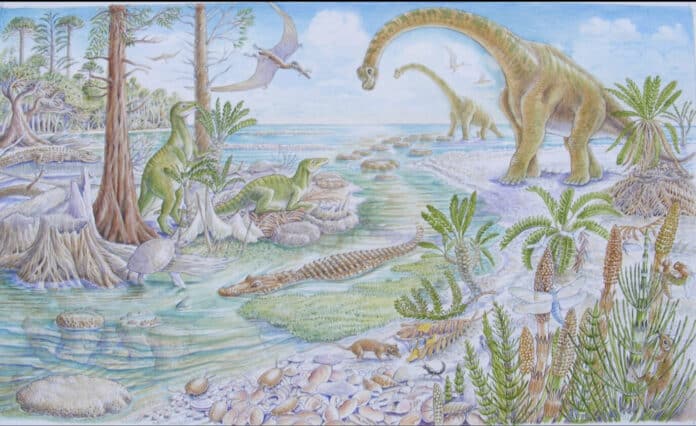Purbeck has had a successful stone industry for centuries and continues today with a number of active quarries. The Portland and Purbeck limestone of late Jurassic and early Cretaceous age (140-150 million years old) is exploited for example at Swanworth Quarry and Keates Quarry near Worth Matravers and Langton Matravers respectively. The stone was formed in a shallow tropical sea (Portland Stone) and then a shallow lagoon (Purbeck Stone). The Portland Limestone is seen along the south coast of Purbeck from Durlston Head to St Aldhelm’s Head as in the picture below, the cliffs at Blackers Hole east of Dancing Ledge. It also occurs inland around Worth Matravers.

Further east and north in Purbeck the Purbeck Limestone occurs at the surface and one of the most commonly used is burr or broken shell limestone. This was formed in the Purbeck lagoon where billions of small oyster type bivalves lived in the shallow water. The picture below is an artist’s impression of the environment at the edge of the Purbeck lagoon. Conifer trees were growing, dinosaurs were walking around leaving their footprints in soft mud but lots of shelly creatures lived in the shallow water too. Wave action in the shallow water carried away the shells and broke them up making shell banks which then formed the broken shell limestone used today. The picture is based on fossils that have been found in Purbeck and is part of the research that was carried out for the Purbeck Keystone Project by the DIGS group. See on line at www.dorsetrigs.org.uk .

Below is a close up of the broken shells on a bedding surface seen at Keates Quarry.

The beds of rock are of varying thickness. Some are suitable for paving and even roofing while other beds are thicker and can be used for wall construction. Walking round villages in Purbeck it is possible to see many examples of the use of the local stone. After all stone is bulky, heavy and difficult to transport especially in historical times when horse and cart was the main means of transport! Below is a picture of St Aldhelm’s Chapel with local stone walls and stone ’slates’ for the roof. The word slates is in inverted commas as they are not true slate (a metamorphic rock for under extreme pressure and moderate heat) but a thinly bedded stone that can be used for roofing. This is common in older buildings seen around Purbeck.

Local stone is still being quarried and used and the picture below shows some stone called spangle which has been used in the entrance to Langton Matravers primary school. This is one of the types of Portland Limestone used. The original shells have become crystalline (the mineral calcite) over the millions of years since they were living in the shallow Jurassic sea. The environment was sub-tropical as what we now call the British Isles was at a latitude of around 30oN with conditions similar to the Caribbean and Mediterranean now.

The limestone produces a thin lime rich soil which is suitable for many flowering plans and in early summer the natural areas of Purbeck are a picture!

Alan Holiday
PLEASE SUPPORT US FOR JUST £2 A MONTH







